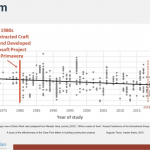(By Hal Macomber, EVP Touchplan and Terri Erickson,) All processes and projects have bottlenecks or constraints. A physical bottleneck determines the maximum rate at which the process flows. Increasing the size of a bottle without changing the size of the bottleneck has no impact on flow. Yet, our everyday experience of bottlenecks can be one of surprise, dismay, or frustration. Let’s shift our relationship to them by taking charge of the bottlenecks.
Background
Terri and Hal studied Eli Goldratt’s work on the Theory of Constraints (ToC) made famous by his book, The Goal, An Ongoing Process of Improvement first published in 1982. Terri teaches ToC in a master’s level course for Engineering Management. Hal has written about ToC for nearly 20 years.
The Goal and ToC were key to the development of the theory and practice of Lean Construction. Greg Howell discovered the book in the 1990s. He was inspired by the story of the boy scout hike and campfire lesson to create the Parade of Trades® simulation, the essential way people in the construction industry are learning about constraints, variation, and compounding effects in project-based production systems.
Clarke Ching, a serious Goldratt student and Agile project expert, has been writing to make Goldratt’s lessons more available and understandable to a larger audience. His book, The Bottleneck Rules: How to Get More Done (When Working Harder isn’t Working), is used in study-action teams in the design and construction industry.
When you see your first bottleneck, it will hit you like a good movie plot twist does, and you will wonder, “How on earth did I not see that until now?” You’ll shake your head in disbelief when you realize that something so seemingly harmless has been sitting there, in plain sight, sucking the life out of your workplace and nobody noticed.
The good news is that you’re not only going to learn to see bottlenecks — you’ll also learn how to tame them and manage them. Your workplace will speed up and, at the same time, calm down. Taming bottlenecks is easy when you can see them.
Clarke Ching, New Zealand, The Bottleneck Rules
Use Bottlenecks for the Benefit of Project Production Systems
Project-based production systems are often short-lived. Pull planning is one common way teams are designing their phase plans. Unfortunately, even people who have been introduced to Lean Construction, pull planning, and bottlenecks don’t often explicitly consider what operation (activity) will limit or control production flow, let alone strategically locate the control point. Consequently, just out of plain sight, the bottleneck does what it always does; it controls the flow through that phase of work. That might impact the phase milestone, or not. If it does, then firefighting ensues.
Alternatively, let’s make a conscious decision when designing a phase of work to place the bottleneck where it is useful for controlling the flow or throughput of the process. Consider the capacity limitations of each operation. You might find that the pace of the lowest capacity limitation is sufficient to support the milestone target. If not, look for alternative means to accomplish the limiting work. Offsite construction, kitting, shift work, etc may help. Pick a visible operation to set the pace for the phase. That operation’s capacity should match the desired pace. All other trades or workgroups adjust their work and team size to match the desired pace. Remember, the throughput of the whole process can’t be more than the throughput of the bottleneck. Any operation that tries to perform at a higher rate will not result in overall gains for the phase milestone.
It helps to place the pacing operation where there are buffers available. We commonly use two types of buffers on projects — time and capacity buffers. Time buffers, known as “float” in scheduling jargon, are best placed at the end of a phase just before the milestone. Time buffers are consumed when slippages occur. Daily overtime and Saturday work are examples of capacity buffers. While our industry uses these buffers, it comes with large risks and detrimental impacts on the team members. Longer hours often negatively increase safety, quality, and productivity. Worse, families are seriously impacted when mom or dad is repeatedly not available for family responsibilities. Smart leaders do not put the quality of life of “our most important assets” at risk.
The better option, use stand-by capacity coupled with workable backlog when designing the phase production plan – especially with pace-setting bottleneck activities. Stand-by capacity is used to fill the gap between the daily average capacity needed and the daily spikes and dips in demand. We set that extra capacity for all crews of the same trade. If plumbing is running four crews with a total of 15 people, they might take care of a large percentage of the daily ups and downs as long as flexing happens between the crews. Alternatively, they may plan for one or two additional people for partial days a few days each week — standby capacity. The rest of the time they are doing work that is ready but not needed until a later time AND will not cause problems for other teams when performed out of sequence, like unpacking product or prefabbing components — workable backlog. We’ll write more about this in future blog posts.
Five Types of Bottlenecks
Clarke Ching distinguishes five usual bottlenecks we encounter on our projects.
- Wild Bottlenecks are often hidden and they are either unmanaged or poorly managed.
- Tamed Bottlenecks don’t have as much capacity as we would like but they are visible and are easily managed.
- A Deliberate bottleneck is designed to deliberately limit the flow through a system – e.g. the bottleneck of a wine bottle or a Tabasco sauce bottle.
- Bottles have necks to control the speed of the content as it flows out.
- A simple place to put a deliberate bottleneck is at the start of a process so that we choke, restrict or throttle the flow of work into the system so the entire system runs at the speed of that control point.
- Right stuff bottlenecks — Are we being effective? Are we working on the right stuff?
- Right place bottlenecks — Are they where they are supposed to be?
We wrote about wild and deliberate bottlenecks. Taming bottlenecks is done with the FOCCCUS process (ToC Focusing mechanism). It’s a step-by-step approach for identifying and systematically improving the situation so the bottleneck is working FOR the process. The steps are Find, Optimize, Coordinate, Collaborate, Curate, Upgrade, and Start again. Learn more from Clarke’s very brief and readable book.
Key Takeaways
Remember, you and your team are responsible for the design of the production system … this includes strategic placement of the bottleneck. Take that opportunity seriously.
- A bottleneck ALWAYS exists — “not having a bottleneck” is not possible — just because you can’t see your bottleneck, doesn’t mean it doesn’t exist
- Do not be a victim of your project’s bottlenecks
- Use bottlenecks as a way to pace the project and control the project
- Place your bottleneck in a location where you maximize buffers available
- There is a probabilistic nature to the whole thing — ACCEPT that there will be times when the bottleneck is working at maximum capacity and other times when it’s not. (more on this later)
- Life still happens — stay on the lookout for previously hidden bottlenecks
- Develop work agreements with your project team so that “bottleneck” activities take priority over other activities.
- This isn’t just about finding the bottleneck this is about DESIGNING the bottleneck(s)
- Shift language from “bottleneck” to “control points” — bottlenecks lead to victims, control points lead to empowerment. . .
- Develop multiple control points — NEVER have EVERYTHING be a control point. Starting work, bottleneck work, and finishing work are great control points.
- Control points should be actively monitored, managed, and improved.
Let’s relentlessly pursue flow by reducing our Project Team’s experiences of surprise, dismay, and frustration by shifting our relationship with bottlenecks and taking charge of them.
If you missed last week’s post please take a moment to read Beware, Variation Compounds with Dependence Data can play a key role to help identify bottlenecks. Learn how Touchplan Insights can help.










